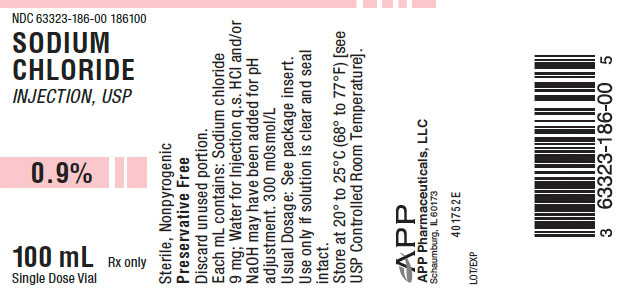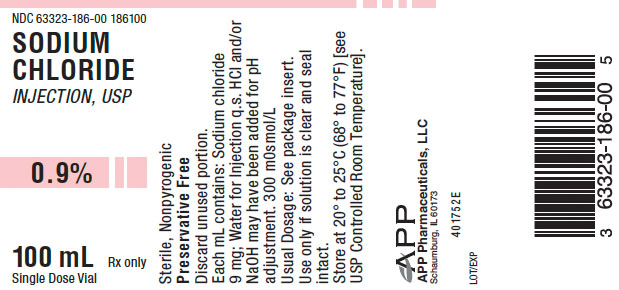Label: SODIUM CHLORIDE injection
- NDC Code(s): 63323-186-00
- Packager: Fresenius Kabi USA, LLC
- Category: HUMAN PRESCRIPTION DRUG LABEL
- DEA Schedule: None
- Marketing Status: unapproved drug other
DISCLAIMER: This drug has not been found by FDA to be safe and effective, and this labeling has not been approved by FDA. For further information about unapproved drugs, click here.
Drug Label Information
Updated October 8, 2019
If you are a consumer or patient please visit this version.
- Download DRUG LABEL INFO: PDF XML
- Official Label (Printer Friendly)
- SPL UNCLASSIFIED SECTION
-
DESCRIPTION
Sodium Chloride Injection, USP, 0.9% is a sterile, nonpyrogenic solution. Each mL contains: Sodium chloride 9 mg; Water for Injection, q.s. Sodium Chloride Injection, USP, 0.9% contains no preservative or added buffer. The osmolarity is 300 mOsmol per liter.
Hydrochloric acid and/or sodium hydroxide may have been added for pH adjustment (4.5-7.0).
Sodium chloride occurs as colorless cubic crystals or white crystalline powder and has a saline taste. Sodium chloride is freely soluble in water. It is soluble in glycerin and slightly soluble in alcohol.
The empirical formula for sodium chloride is NaCl, and the molecular weight is 58.44.
-
CLINICAL PHARMACOLOGY
Sodium chloride comprises over 90% of the inorganic constituents of the blood serum. Both its ions are physiologically important. Sodium, more than any other ion, determines the osmotic pressure of interstitial fluids and the degree of hydration of tissues. When the intake of the chloride ion is less than is excreted, there is a relative increase in the blood bicarbonate level, producing the condition known as alkalosis. Other symptoms of sodium chloride deficiency are nausea and vomiting and increased irritability of muscles, evidenced by cramps and possibly convulsions. It is well known that excessive sweating will cause ‘‘heatcramps,’’ i.e., muscle cramps in the abdomen and extremities, which can be completely relieved only by ingestion of a weak salt solution.
Approximately 25% of the total body sodium is found in the bone. The regulation of salt and water metabolism is governed by different mechanisms; however, changes in the intake distribution and output of salt are, in health, associated with collateral shifts of water so that electrolyte concentrations are maintained within a narrow range. In the presence of disease affecting the cardiovascular, hepatic or renal system or in certain endocrinologic disorders, changes in the rate of excretion of salt and water will disturb the homeostatic equilibrium. Frequently, abnormalities in the metabolism of water or salt may occur as a result of vomiting, diarrhea, gastrointestinal suction and fever. Excessive sweating will produce loss of water or salt, but since the electrolyte concentration is hypotonic, loss of water will predominate.
The normal salt intake ranges from 5 to 15 grams daily, most of which is excreted by the kidneys. The control of water and salt excretion in urine is very intricate, involving filtration by the glomerulus and reabsorption by the tubules of approximately 99% of the filtered load. The actual quantities excreted depend on the requirements prevailing at the moment. The finer adjustments of the tubular absorptive mechanisms are influenced by osmotic interrelationships between cell water, plasma and urine and by certain steroid hormones influencing electrolyte excretion and the posterior pituitary hormone regulating water excretion. When food intake ceases or salt is withheld, the content of sodium chloride in urine diminishes rapidly so that the body stores are retained. Similar renal retention of electrolyte occurs when salt is lost via gastrointestinal secretions through vomiting, etc. In other conditions, such as congestive heart failure, cirrhosis, nephritis or hypersecretion of the adrenal cortical hormones, the kidney fails to eliminate sufficient sodium. This results in retention of both salt and water, producing an excessive accumulation of extracellular fluid, which may be effectively combatted by a sharp restriction of salt intake and use of a diuretic.
Depletion of body salt may be caused in many ways, one of which is too energetic treatment of fluid and sodium retention. Besides this, diabetic acidosis, burns, excessive sweating with free drinking of water, repeated paracentesis for removal of ascitic fluid, adrenal cortical hypofunction and certain forms of nephritis, as well as abnormal losses of gastrointestinal secretions, will cause marked salt depletion. With salt loss, there is a reduction of the osmotic pressure of the extracellular fluid; the urine volume may be retained, but it is free of sodium chloride.
-
INDICATIONS AND USAGE
Sodium Chloride Injection, USP, 0.9% preparations are indicated for diluting or dissolving drugs for intravenous, intramuscular or subcutaneous injection according to instructions of the manufacturer of the drug to be administered.
Sodium Chloride Injection, USP, 0.9% is also indicated for use as an irrigation solution as well as for use in flushing of intravenous catheters.
-
WARNINGS
In flushing intravenous catheters with Sodium Chloride Injection, USP, 0.9%, only a preservative-free formulation should be used. Where a sodium chloride solution is required for preparing or diluting medications for use in newborns, only preservative-free Sodium Chloride Injection, USP, 0.9% should be used.
-
PRECAUTIONS
General
Sodium chloride must be used with caution in the presence of congestive heart failure, circulatory insufficiency, kidney dysfunction or hypoproteinemia.
Excessive amounts of sodium chloride by any route may cause hypopotassemia and acidosis. Excessive amounts by the parenteral route may precipitate congestive heart failure and acute pulmonary edema, especially in patients with cardiovascular disease and in patients receiving corticosteroids or corticotropin or drugs that may give rise to sodium retention.
Pregnancy Category C
Animal reproduction studies have not been conducted with Sodium Chloride Injection, USP, 0.9%. It is also not known whether Sodium Choride Injection can cause fetal harm when administered to a pregnant woman or can affect reproduction capacity. Sodium Chloride Injection, USP, 0.9% should be given to a pregnant woman only if clearly needed.
-
ADVERSE REACTIONS
Reactions which may occur because of this solution, added drugs or the technique of reconstitution or administration include febrile response, local tenderness, abscess, tissue necrosis or infection at the site of injection, venous thrombosis or phlebitis extending from the site of injection and extravasation.
If an adverse reaction does occur, discontinue the infusion, evaluate the patient, institute appropriate countermeasures, and if possible, retrieve and save the remainder of the unused vehicle for examination.
-
OVERDOSAGE
When used as a diluent, solvent, irrigation solution or intravascular flushing solution, this parenteral preparation is unlikely to pose a threat of sodium chloride or fluid overload except possibly in very small infants. In the event these should occur, reevaluate the patient and institute appropriate corrective measures. See PRECAUTIONS and ADVERSE REACTIONS.
-
DOSAGE AND ADMINISTRATION
Before Sodium Chloride Injection, USP, 0.9% is used as a vehicle for the administration of a drug, specific references should be checked for any possible incompatibility with sodium chloride.
The volume of the preparation to be used for diluting or dissolving any drug for injection is dependent on the vehicle concentration, dose and route of administration as recommended by the manufacturer.
Sodium Chloride Injection, USP, 0.9% is also indicated for use in flushing intravenous catheters. Prior to and after administration of the medication, the intravenous catheter must be flushed in its entirety with 2 mL of Sodium Chloride Injection, USP, 0.9%. Use in accord with any warnings or precautions appropriate to the medication being administered.
Parenteral drug products should be inspected visually for particulate matter and discoloration prior to administration, whenever solution and container permit.
-
HOW SUPPLIED
Sodium Chloride Injection, USP, 0.9%, is supplied as:
Product
No
NDC
No
Strength
186100
63323-186-00
0.9%
100 mL single dose vial with a tear-off seal, in packages of 25.
Preservative free. Discard unused portion.
Use only if solution is clear and seal intact.
Store at 20° to 25°C (68° to 77°F) [see USP Controlled Room Temperature].
- SPL UNCLASSIFIED SECTION
- PRINCIPAL DISPLAY PANEL
-
INGREDIENTS AND APPEARANCE
SODIUM CHLORIDE
sodium chloride injectionProduct Information Product Type HUMAN PRESCRIPTION DRUG Item Code (Source) NDC:63323-186 Route of Administration INTRAVENOUS, INTRAMUSCULAR, SUBCUTANEOUS Active Ingredient/Active Moiety Ingredient Name Basis of Strength Strength SODIUM CHLORIDE (UNII: 451W47IQ8X) (SODIUM CATION - UNII:LYR4M0NH37, CHLORIDE ION - UNII:Q32ZN48698) SODIUM CHLORIDE 9 mg in 1 mL Inactive Ingredients Ingredient Name Strength HYDROCHLORIC ACID (UNII: QTT17582CB) SODIUM HYDROXIDE (UNII: 55X04QC32I) Packaging # Item Code Package Description Marketing Start Date Marketing End Date 1 NDC:63323-186-00 25 in 1 TRAY 08/10/2000 1 100 mL in 1 VIAL, SINGLE-DOSE; Type 0: Not a Combination Product Marketing Information Marketing Category Application Number or Monograph Citation Marketing Start Date Marketing End Date unapproved drug other 08/10/2000 Labeler - Fresenius Kabi USA, LLC (608775388) Establishment Name Address ID/FEI Business Operations Fresenius Kabi USA, LLC 840771732 manufacture(63323-186)



